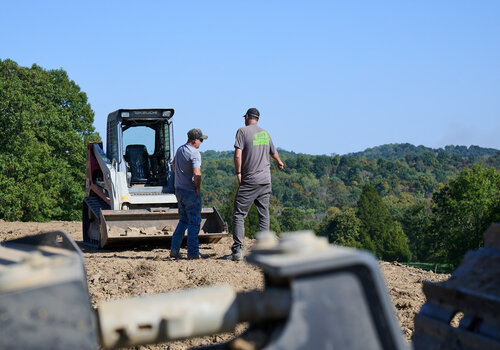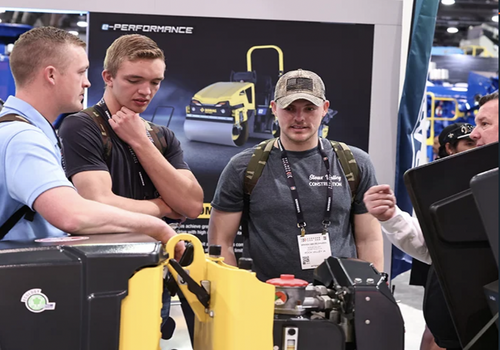If you’ve ever watched a paving shift stall because the roller operator called in—or a utility crew lost a day waiting on a CDL driver—you already know why cross-training matters. With demand steady and skilled labor tight, the crews that win are the ones that swap roles safely, keep production moving, and cover gaps. This is true for large and small companies.
WHY NOW: BACKLOG IS REAL, PEOPLE ARE SCARCE
Contractors continue to report healthy pipelines. ABC’s latest Construction Backlog Indicator shows roughly 8–9 months of work on average, a sign that owners still expect delivery even as the market shifts. At the same time, the industry is still struggling to find workers. Put together, the message is clear: you’ll have the work, but not always the perfect roster to staff it. Cross-training turns that constraint into an advantage.
WHAT CROSS-TRAINING REALLY DOES FOR A CREW
Keeps production moving. When an excavator operator can jump on the skid, or a grade checker can run the rover, small disruptions stay small. Studies on construction labor show a need for better scheduling resilience and higher productivity in resource-constrained environments—exactly the reality on most jobsites.
Improves quality and safety. People who understand the next trade’s needs (e.g., paving crew aware of roller pass patterns, or pipe crew that knows QC checkpoints) make fewer handoff errors. By upskilling your workforce, you not only retain the most talented workers, but you are prepared for unexpected situations.
Grows careers. As automation and advanced technology become common on jobsites, training all workers on emerging trends will help you stay ahead of the competition and attract the next generation of workers.
THREE PRACTICAL WAYS TO GET STARTED
1) Build a simple skills matrix (and keep it live).
List critical tasks for each crew (e.g., set up/tear down traffic control, run 3D rover, e-ticketing, compaction mapping, basic equipment inspections). Mark who is Qualified (Q), Practicing (P), and Learning (L). Your first goal: have at least two Qs for every mission-critical task per shift. Review weekly in the tailgate or foreman meeting and target one upgrade per person each month. This gives you a roadmap and proves progress to the office.
2) Train to real work, not just a binder.
Adopt a 70-20-10 approach: 70% on-the-job reps (micro-drills), 20% coaching, 10% formal training.
Examples:
-
Paving: teach laborers to run the roller in static on a low-risk lift; then add vibration settings guided by the operator and the IC screen.
-
Dirt: let grade checkers set stakes under supervision, then transition to rover workflows.
-
Utilities: have a top laborer pre-assemble fittings, then practice machine-assisted pipe setting with a spotter.
These small, frequent reps build competence quickly—and tie directly to productivity and quality.
3) Rotate roles on purpose.
Don’t wait for a sick day. Schedule planned rotations on lower-risk windows (e.g., first lift, cleanup, or non-critical haul). A simple cadence—“every Thursday first half, backups run”—builds confidence without risking critical milestones. Pair each learner with a mentor and make “why” explicit: how this task affects the next trade, the schedule, and safety. You’ll notice handoffs improve because people see the downstream impacts of their work.
COMMON PITFALLS (AND HOW TO AVOID THEM)
-
“One and done” training. Skills fade fast without reps. Schedule micro-drills weekly; tie them to real production.
-
Skipping the spec. A cross-trained operator is only useful if they know the acceptance criteria (e.g., compaction windows, tolerances). Build mini-checklists into the task.
-
Ignoring credentials. Don’t put unqualified people into regulated roles (crane, rigging, electrical). Keep your matrix honest and your sign-offs documented.
SELL IT TO YOUR TEAM THE RIGHT WAY
Start small: publish a skills matrix, plan one rotation per week and celebrate the first avoided delay. That’s how you turn a good crew into a versatile crew—the kind that keeps jobs moving, no matter what the day throws at you.
Cross-training is not about replacing specialists; it’s about making the day easier. People get more marketable skills, crews get more resilient, and leaders get more options when things go sideways.
Keep the training momentum going this summer with Why Safety Training is Key to Workforce Development in Construction and 5 Ways to Prepare Your Workforce for the AV Era.
Photo Credit: Photo Courtesy CONEXPO-CON/AGG 365












